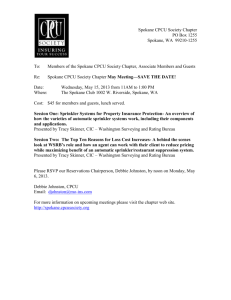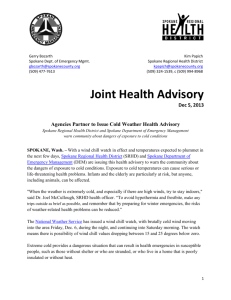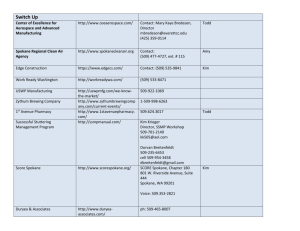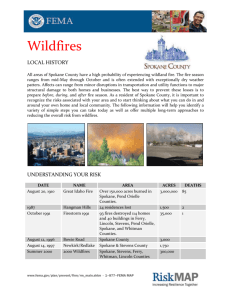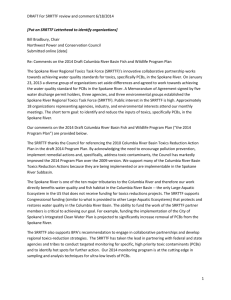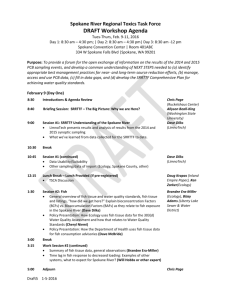Boilerplate Paragraphs SRRTTF
advertisement
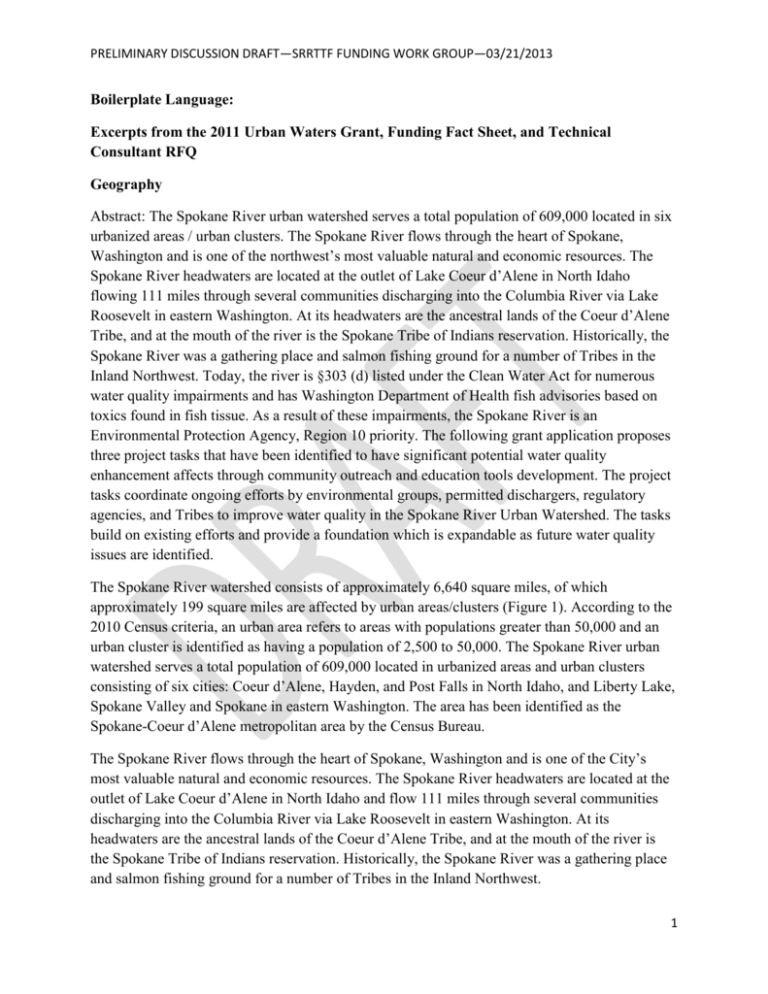
PRELIMINARY DISCUSSION DRAFT—SRRTTF FUNDING WORK GROUP—03/21/2013 Boilerplate Language: Excerpts from the 2011 Urban Waters Grant, Funding Fact Sheet, and Technical Consultant RFQ Geography Abstract: The Spokane River urban watershed serves a total population of 609,000 located in six urbanized areas / urban clusters. The Spokane River flows through the heart of Spokane, Washington and is one of the northwest’s most valuable natural and economic resources. The Spokane River headwaters are located at the outlet of Lake Coeur d’Alene in North Idaho flowing 111 miles through several communities discharging into the Columbia River via Lake Roosevelt in eastern Washington. At its headwaters are the ancestral lands of the Coeur d’Alene Tribe, and at the mouth of the river is the Spokane Tribe of Indians reservation. Historically, the Spokane River was a gathering place and salmon fishing ground for a number of Tribes in the Inland Northwest. Today, the river is §303 (d) listed under the Clean Water Act for numerous water quality impairments and has Washington Department of Health fish advisories based on toxics found in fish tissue. As a result of these impairments, the Spokane River is an Environmental Protection Agency, Region 10 priority. The following grant application proposes three project tasks that have been identified to have significant potential water quality enhancement affects through community outreach and education tools development. The project tasks coordinate ongoing efforts by environmental groups, permitted dischargers, regulatory agencies, and Tribes to improve water quality in the Spokane River Urban Watershed. The tasks build on existing efforts and provide a foundation which is expandable as future water quality issues are identified. The Spokane River watershed consists of approximately 6,640 square miles, of which approximately 199 square miles are affected by urban areas/clusters (Figure 1). According to the 2010 Census criteria, an urban area refers to areas with populations greater than 50,000 and an urban cluster is identified as having a population of 2,500 to 50,000. The Spokane River urban watershed serves a total population of 609,000 located in urbanized areas and urban clusters consisting of six cities: Coeur d’Alene, Hayden, and Post Falls in North Idaho, and Liberty Lake, Spokane Valley and Spokane in eastern Washington. The area has been identified as the Spokane-Coeur d’Alene metropolitan area by the Census Bureau. The Spokane River flows through the heart of Spokane, Washington and is one of the City’s most valuable natural and economic resources. The Spokane River headwaters are located at the outlet of Lake Coeur d’Alene in North Idaho and flow 111 miles through several communities discharging into the Columbia River via Lake Roosevelt in eastern Washington. At its headwaters are the ancestral lands of the Coeur d’Alene Tribe, and at the mouth of the river is the Spokane Tribe of Indians reservation. Historically, the Spokane River was a gathering place and salmon fishing ground for a number of Tribes in the Inland Northwest. 1 PRELIMINARY DISCUSSION DRAFT—SRRTTF FUNDING WORK GROUP—03/21/2013 Water Quality Problems Today, the river is §303 (d) listed under the Clean Water Act for numerous water quality impairments and has Washington Department of Health fish advisories based on toxics found in fish tissue. As a result of these impairments, the Spokane River is an Environmental Protection Agency (EPA), Region 10 priority. It is also one of three waterways selected by the Washington Department of Ecology (Ecology) to participate in the State’s Urban Water’s Initiative, whose goal is to address specific challenges and provide additional resources to prevent contamination or re-contamination of urban waterways. The Spokane River Regional Toxics Task Force _________________________ Our Vision - The Regional Toxics Task Force will work collaboratively to characterize the sources of toxics in the Spokane River and identify and implement appropriate actions needed to make measurable progress towards meeting applicable water quality standards for the State of Washington, State of Idaho, and The Spokane Tribe of Indians and in the interests of public and environmental health. Background The State of Washington Department of Ecology (Ecology) and the EPA are doing something different than a TMDL to address toxics in the Spokane River. To accelerate clean‐up actions, interests groups and governments in the Spokane River basin have collaborated on a unique and innovative approach to reduce PCBs and dioxins in the river. They are pursuing a direct‐to‐implementation strategy that includes the establishment of a Spokane River Regional Toxics Task Force (Toxics Task Force) to identify and reduce PCBs and dioxins at their source in the watershed. PCB pollution in the Spokane River is not coming from a few isolated point sources. It is diffuse and difficult to trace. A PCB Source Assessment prepared by Ecology leaves many unanswered questions with respect to the sources of PCBs in the Spokane River. The Assessment identified less than 50% of the sources that contribute to the observed concentrations of PCBs in the river. A consistent method for collecting and analyzing toxics data is necessary in identifying the sources of PCBs in the watershed and implementing clean up actions. 2 PRELIMINARY DISCUSSION DRAFT—SRRTTF FUNDING WORK GROUP—03/21/2013 _________________________ The 2011 Washington NPDES wastewater discharge permits issued by the Department of Ecology for facilities discharging into the Spokane River include the requirement for creation of a Spokane River Regional Toxics Task Force (Task Force). The permits also indicate that to accomplish the goals of the Task Force, the Task Force may provide for an independent community technical advisor(s) who shall assist in review of data, studies, and control measures, as well as assist in providing technical education information to the public. The Task Force was formed in late 2011 and early 2012, and a Memorandum of Agreement (MOA) was established. _____________________________ In 2011, Ecology issued National Pollutant Discharge Elimination System (NPDES) Waste Discharge permits to Washington industrial and municipal dischargers that discharge to the Spokane River. In an effort to address toxics, NPDES permits require dischargers to develop and support the Spokane River Regional Toxics Task Force (Task Force). The Task Force membership represents state, tribal, municipal, industrial, Idaho and Washington environmental agencies, and community groups representing interdisciplinary expertise regarding water quality. The thirteen current Task Force member entities include industrial dischargers, Inland Empire Paper and Kaiser; municipal dischargers, Liberty Lake Sewer and Water District, Spokane County, City of Spokane; environmental groups, Lake Spokane Association, Spokane Riverkeeper, and Sierra Club; and regulatory agencies, Ecology and Spokane Regional Health District. The Spokane Tribe of Indians, Coeur d’Alene Tribe of Indians and EPA are directly involved as sovereigns. In addition, more that thirteen public and private entities provide support and/or collaborate with the Task Force, including the Spokane River Forum. The focus of the Task Force is the development of a comprehensive plan to bring the Spokane River into water quality compliance with respect to toxics on the Washington 2008, Category 5, 303(d) list (PCBs and Dioxins). One of the goals of the Task Force is the development of a technical work plan that addresses the following components: • Approach for and analysis of existing data on PCBs and other toxics and identification of data gaps. • Development and implementation of a Monitoring Plan for the Spokane River. • Establishment of a publicly accessible clearinghouse for storing data, reports, Task Force meeting minutes or summaries, and other information gathered or developed by the Task Force and its members. • Review of proposed Toxic Management Plans, Source Management Plans, and Best Management Plans (BMPs). 3 PRELIMINARY DISCUSSION DRAFT—SRRTTF FUNDING WORK GROUP—03/21/2013 • Public education needs and approach, including pollution prevention and public and environmental health determinations. [Include Paragraph about MOA and signatories to the MOA] + The current Task Force member entities include industrial dischargers, Inland Empire Paper and Kaiser; municipal dischargers, Liberty Lake Sewer and Water District, Spokane County, City of Spokane; environmental groups, Lake Spokane Association, Spokane Riverkeeper, and regulatory agencies, Ecology and Spokane Regional Health District. [Add Partner Organization Paragraphs] The Lands Council The Lands Council is the submitting organization and will manage the grant. They have been working for years on outreach to environmentally vulnerable and sensitive groups in the urban watershed. The Lands Council has built awareness of the health risks of Spokane River toxics, particularly in economically-disadvantaged and ethnic communities and among underprivileged youth. They work diligently to reduce human exposure to toxics, protect public health, and to involve the public in Spokane River clean-up and restoration activities. Spokane Riverkeeper The Spokane Riverkeeper is a local non-profit citizens' organization dedicated to protecting and restoring the health of the Spokane River Watershed. The Spokane Riverkeeper is working to reduce PCBs and other toxics from the Spokane River to ensure an improvement in ecological health and the health of surrounding communities. A component of that work has been education and outreach in the Spokane community. Current projects include work with St. Georges Elementary school students to pilot student water quality testing on the Little Spokane River, including observational recording such as local weather conditions and changes in the ecosystem. City of Spokane The City of Spokane is committed to reduction of toxics to the Spokane River. As a member of the Forum and the Task Force, they will provide expertise with respect to development of outreach to elected officials. They have vast experience with this and have developed other materials used to educate and inform the City Council and Mayor after each election cycle. Washington State Department of Ecology Ecology has been working on research and improvement of the Spokane River urban watershed for over 40 years. They have created many informational guidance documents for the public with respect to building awareness about River health and environmental stewardship. The Urban Waters program at Ecology is working on a Geospatial Information System (GIS) 4 PRELIMINARY DISCUSSION DRAFT—SRRTTF FUNDING WORK GROUP—03/21/2013 tool. The GIS application will be a multi-functional analysis tool that will have the following uses: contaminant tracing over land and within piped systems, pollutant loading analysis assessments under various scenarios, and predict/measure BMP effectiveness. Because the tool will be web accessible, stakeholders will be able to view and, with permission, use the tool. In addition, the public will have access to a set of tools. The GIS work underway at Ecology can be built upon by the Task Force, community, and environmental interests to suit their needs for source tracking and public education." Benefits to the Community The economic health and welfare of the Spokane-Coeur d’Alene metropolitan area is largely dependent upon the natural resources of the region. The potential health impacts identified by the Washington State Department of Health in setting fish consumption rates will significantly impact recreational and sports fishing activities. The creation of economic opportunities requires many businesses to obtain water quality permits prior to discharging to existing facilities. Before these permits can be issued, the river must be in compliance with respect to Clean Water Act water quality limits. This will require significant community effort toward management of legacy pollutants. 5
